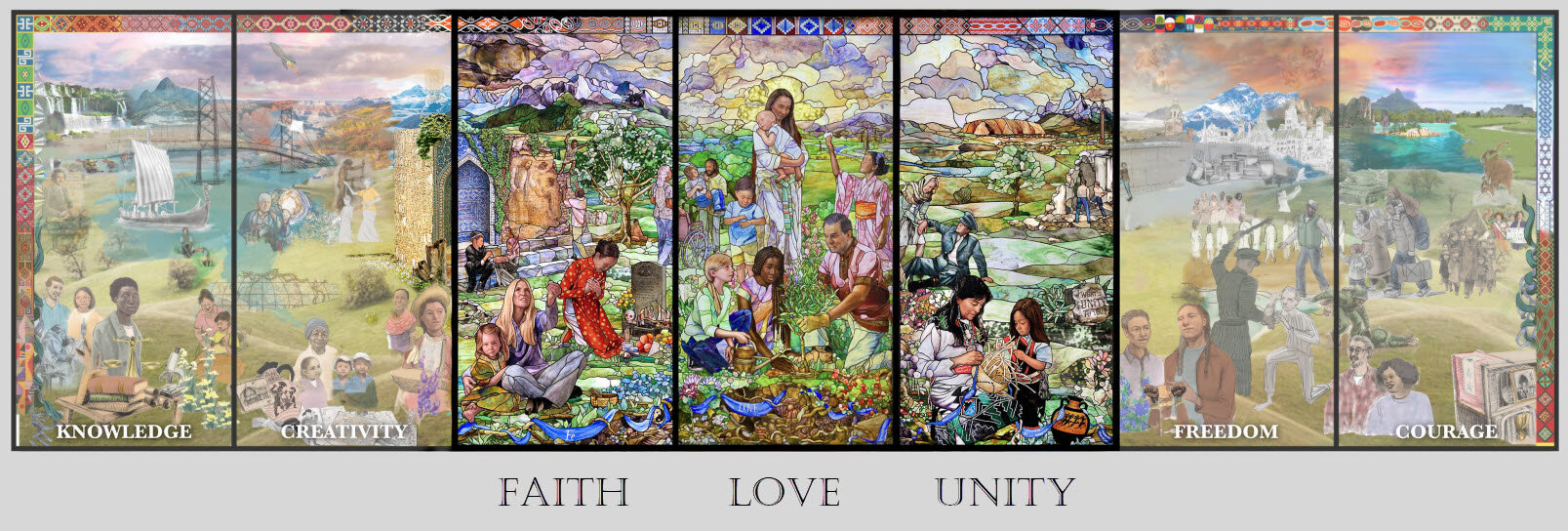Roots of Humanity LOVE Panel Illuminating Human Potential
Through the talents at Holdman Studios, we introduce the Roots of Humanity, an unprecedented showcase of glass art depicting the delicate story of human existence. Focusing on pivotal moments in history, it portrays humanities struggles and achievements as men and women work to fulfill their potential and improve the world around them.
We are creating panels for the seven pillars of humanity. Here is a description of the LOVE panel written by Gayle Holdman.
The panel displayed here is the first of seven and focuses on LOVE, along with: Charity, Sympathy, Empathy, Kindness, Tolerance, Acceptance, Esteem, Respect, Generosity, Forgiveness, and Compassion. These words are shown written in the six recognized languages of the United Nations along with visual illustrations and quotes in their originally stated languages symbolizing those concepts.
Each panel will contain recognizable landscapes of one of the seven continents. Africa is displayed on the Love panel.
At the center of the Love panel is Mother Earth nurturing the human race. Notice the daisies that flow upward from the ground directly into the skirt of her human embodiment. The outer arch above her head is a montage of mythological and cultural stories regarding the creation of the earth and the origins of humankind.
Directly above her head is subtle imagery of the brain, suggesting the remarkable potential of thought and the miracle that is the human mind. Therein lies the capacity of conscious choice to focus our thoughts, feelings, and actions towards the betterment of all around us.
Mother Earth is surrounded by children of the world, each of which is representing particular human experiences:
The youngest infant on her shoulder represents the most vulnerable. He gazes at a butterfly with wonder and awe. A young boy beneath him tenderly cares for a caterpillar. The butterfly, once the caterpillar, shows the resulting beauty and goodness available if we are conscientious stewards over each other and this planet.
To the right of Mother Earth, a young girl holds out an origami crane that she has made. This hearkens to the Japanese legend embraced by Sadako Sasaki that if one took the time and energy to fold 1,000 paper cranes, they were entitled to a “wish” or to special healing. This young woman is offering her efforts for the healing of the planet itself.
On the opposite side is the tender and emotional moment a young man with disabilities receives his first wheelchair. The gentleman carries him there with gratitude and compassion.
Below, three people plant a young tree: the Tree of Hope for Humanity. This scene illustrates the imparting of wisdom to the next generation. Just as the tree will grow, the knowledge, hope, skills, inspiration, and cooperation shared will lead to the growth of each individual involved. The watering can held by one of the young girls contains the world’s most precious resource, water, which she most generously shares. The other girl adds soil to strengthen the foundation of the tree perhaps as a young Wangari Maathai might have done. The olive wreath from the United Nations’ symbol is found within the tree.
The roots of the Tree feed out into all cultures and aspects of humanity. They weave with the ribbons that include the positive characteristics that love encapsulates. These ribbons blend into the border being the “fabric of our lives”- the interwoven collection of humanity’s experiences and memories. Made up of culturally iconic designs from around the world, reminiscent of a DNA strand, each style of fabric runs together illustrating the beauty found in both our diversity and the connected unity of being one race on one planet.
At the base of the Tree lies a human embryo, the beginning of life for all, whose umbilical cord is joined with the roots.
In the lower left corner of the panel, you see the roots weaving around the shapes of the seven continents of planet earth. Fused within each of those pieces of glass is actual soil from the continent it represents.
As a team of artists, we place our hope in each individual to take the opportunity to make these positive human characteristics more commonplace and emphasized in our daily lives. May we each have a greater sense of our deep worth and potential and that of all others which will lead to a more glorious and fulfilling world.




